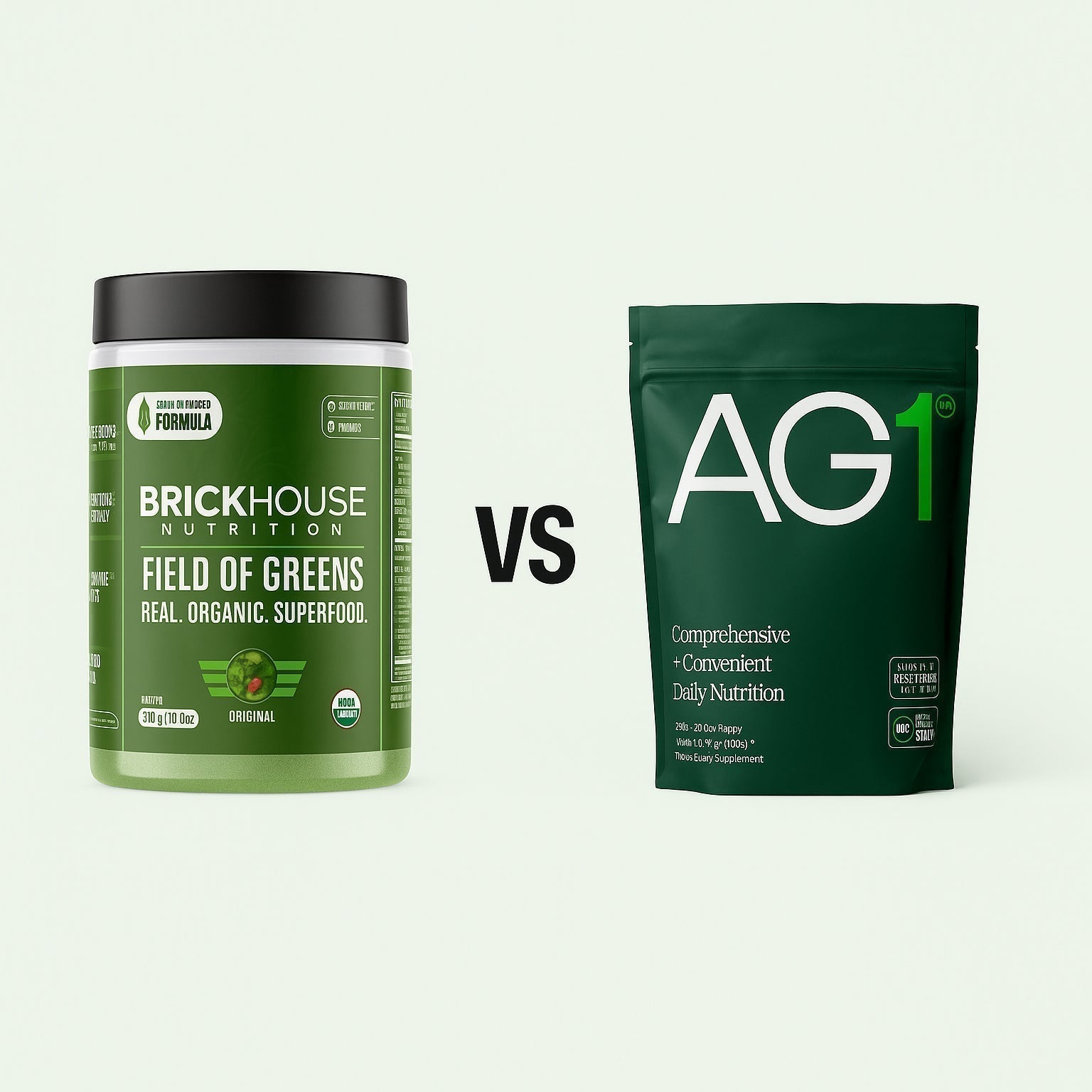Your cart is empty
Free shipping on all US orders


Free shipping on all orders

In the world of greens powders, AG1 by Athletic Greens might be the most recognized brand out there. But notoriety doesn’t always equal the best option. We sat down with Dr. Mike Kim, DO, MBA, Head doctor & formulator at BrickHouse Nutrition, to break down how Field of Greens compares to AG1 — not based on marketing, but on the formula itself.
Here’s what we found.
Let’s just get this out of the way: Field of Greens and AG1 are fundamentally different products.
“They’re trying to do a lot with one product,” Dr. Mike said. “It’s more like a multivitamin/probiotic/superfood/greens blend.”
AG1 is formulated to be an “all-in-one” solution. It’s heavy on extracts, not whole foods. It includes vitamins, minerals, probiotics, digestive enzymes, mushroom blends, and more — all packed into one 12g scoop.
Field of Greens, on the other hand, is laser-focused on delivering actual fruits and vegetables. No synthetic vitamins. No “all-in-one” claims. Just real, organic, whole food ingredients that fill in the gaps most people miss in their diets.
This is one of the biggest differences.
Field of Greens is made from desiccated fruits and vegetables. That means the produce is dried, ground, and preserved with minimal processing. It’s food — just powdered.
AG1 uses extracts, which can sometimes provide higher levels of specific nutrients, but also remove important components like fiber, enzymes, and the full spectrum of benefits found in whole fruits and vegetables.
“We never wanted to tell someone they’re getting fruits and vegetables when it’s really cranberry extract and green tea extract,” said Dr. Mike.
So if you’re looking to actually get more fruits and vegetables in your diet, Field of Greens is much closer to the real thing.
*BrickHouse Field of Greens Nutrition Facts
Another major distinction? Field of Greens uses a Nutrition Facts panel, not a Supplement Facts panel. Our blend might be proprietary, but none of our ingredients are.
That’s because it’s real food.
AG1 is regulated like a supplement. Its blend includes proprietary blends, which obscure exact amounts of key ingredients. That’s common in the supplement world, but not great if you’re trying to understand exactly what you’re putting in your body.
Let’s break down AG1’s 12g scoop.
According to Dr. Mike, 3.5 to 4 grams of that is probably spirulina, which is a low-cost green that’s often used for its color and density. It’s also one of the most dominant flavors.
“It’s what most models of greens powders are based on,” he said. “Not necessarily bad, but not a substitute for a true mix of fruits and veggies.”
The rest of the AG1 formula includes:
Extracts (not organic)
Digestive enzymes
A mushroom complex (154 mg)
A small dose of pea protein isolate (~2.7g)
7.2 billion CFUs (Colony Forming Units) of probiotics (which, Dr. Mike
notes, is low for a true probiotic product)
Compare that to Field of Greens, which includes:
12g of real organic fruits and vegetables
USDA and IQA certified organic compliant, naturally derived vitamins and minerals
Antioxidants, fiber, and prebiotics
No synthetics or proprietary blends in our ingredients

AG1 has one flavor. Field of Greens has 7 options, including:
Original
Wildberry
Strawberry Lemonade
Lemon Lime
Raw (no sweeteners)
Charged (with caffeine from coffee berry)
Taste-wise, AG1’s spirulina-heavy profile is polarizing. Field of Greens was designed to be easy to drink.
“It had to taste good,” Dr. Mike said. “People drink it and feel like the Kool-Aid man.”
You’re not choking it down just to get your greens in.
Simple: AG1 is positioned as a premium all-in-one. It’s marketed as a comprehensive daily ritual. And to be fair, it includes a wide array of ingredients that some people may find valuable.
But from a cost-per-gram-of-real-food perspective, it’s not close.
Field of Greens delivers 12 full grams of actual organic produce for a lower price point.
“They’re trying to be a multivitamin, probiotic, greens, all at once,” Dr. Mike said. “We’re focused on fruits and vegetables. That’s it.”
If you want a multivitamin, a probiotic, and a greens powder all rolled into one — AG1 might be a more basic choice.
But if your goal is to
get more fruits and vegetables into your diet,
Field of Greens
is the more honest, targeted, and transparent product. No gimmicks. No synthetic fillers. Just real food in powder form.